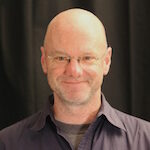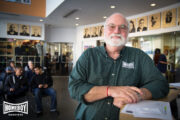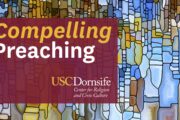On the Wednesday that marked the midpoint in the recent weeklong Pentecostal and Charismatic Research Initiative (PCRI) conference outside Nairobi, about 30 research fellows and CRCC staffers trundled onto a pair of big tour buses that took us to the Vincentian House of Prayer on the west side of the city.
We mostly passed through leafy ’burbs with upscale shops and gated compounds, though a wrong turn briefly landed us in the Kawangware slum. As our bus drivers negotiated awkward turnabouts in front of open-air stalls selling everything from freshly butchered goat to disposable cell phones, a few of my fellow travelers discretely snapped photos of the gritty, unpaved bustle of a typical Two-Thirds World commercial district. One religious studies scholar exchanged friendly banter with a would-be “tour guide” who sidled up to his open window. Most of us quietly took in some of the concrete realities—urban overcrowding, economic inequality, social dislocation and a general need for a sense of empowerment in unsettled circumstances—that had figured more abstractly into the previous days’ conversation about the growth of Pentecostalism and Charismatic Catholicism in the developing world.
At the Vincentian House of Prayer, we met priests from an order founded in southern India who supervise charismatic rites and services in a community of several thousand—and composed mainly of women. One member of our group noted several representations of a fair-skinned, blue-eyed Jesus and asked our hosts why they used that image in a Kenyan church. One young priest—a Catholic convert from Kerala—said he had never noticed those features on the icons before, which later spawned some wry commentary about white scholars chiding brown clerics on the need for a black Savior.
A spokesman for the House of Prayer remarked during our Q&A session that a few years earlier the hierarchy of the Nairobi diocese had banned charismatic ministries for several months. His response to a follow-up question about the reason for the disciplinary action was sketchy, but the likely answer became more apparent as the PCRI group made its way from the administration building toward the large, revival-style tent where a lively service was under way.
The earthy sound of a call-and-response hymn drew my attention away from the din of the tent to a small brick chapel. I fell behind the group and lingered outside the chapel near a window; I was unsure whether closer attention would be welcome. The door opened and a woman stepped onto the covered porch. After I pointed into the little building with an inquiring look, she smiled and nodded.
Inside, about a dozen women knelt in front of a low altar beneath a burnished wooded cross. There were no pews. The blue-walled space was brightly sunlit, and a large porcelain statue of the Virgin gazed down at the women from a niche near the front of the room.
“Christ have mercy,” the women chanted. “We need your mercy,” one of them sang in response. The plainsong continued for about five minutes, followed by a group recitation of Isaiah 56—in which God declares his place of worship “a house of prayer for all people.”
Afterward, one of the women softly began to pray aloud, and soon all the women were praying. “Come Holy Spirit,” one woman beseeched. Another pleaded, “Forgive us!” Over the next six or seven minutes, most of the keening prayers became unhooked from any sort of formal language, and the women’s voices rose and fell in a dramatic, unscripted rhythm like a flock of sonic sparrows—they were praying in tongues.
As the energy of the event ebbed, someone took up another plainsong-style chant and the other women began to join in. I left the group as I had found it, but altogether different.
Robert Dowd—a PCRI fellow who has studied Catholic Charismatic Renewal movements in Kenya, Zimbabwe and Nigeria—later told me that the institutional rap against prayer groups like the one I had witnessed is that they are anti-clerical. In a sense, that orthodox wariness is understandable: no priest was on hand to guide a very powerful ritual, and all of the participants were women.
But Dowd said his research shows that Charismatics like those at the Vincentian House of Prayer are remarkably devoted Catholics, and their appropriation of Pentecostal modes of worship tends to reinforce rather than weaken their ties to the Church.
As advertised, the spirit of the movement is renewal rather than rebellion.
Still, the invocation of the Holy Spirit by a dozen fervent women in a poor Catholic community on the edge of a slum in Nairobi highlights the fact that “renewalist” movements are a potent and sometimes confounding social phenomenon. They can be both the consequence and the cause of disruptions that we associate with globalization in the developing world.
How is the growth of Pentecostal and Catholic renewalism playing out in other parts of the Global South? Stay tuned.
Nick Street was a senior writer with the USC Center for Religion and Civic Culture.







